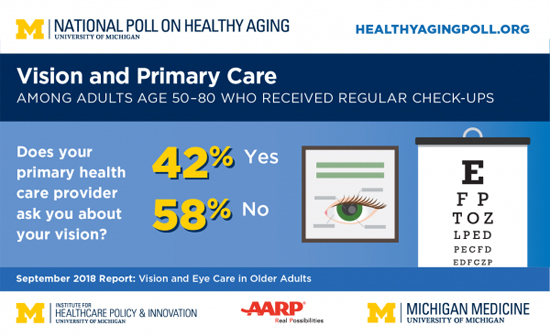Focus on Aging Eyes: Poll Finds Primary Care Providers Play a Key Role in Vision Care After 50Convenience, cost, and lack of insurance coverage also affect eye care decisions, U-M-AARP National Poll on Healthy Aging shows A new poll suggests that primary care providers could play an important role in promoting vision care for adults age 50 and older, especially for those most in need of eye exams, and those most sensitive to the cost. In all, 18% of respondents to the National Poll on Healthy Aging said they hadn't had their eyes checked by an eye doctor in three years or more, or were not sure when they had their last eye exam by an optometrist or ophthalmologist. While guidelines vary for eye exams for older adults, those with diabetes, a history of eye disease, or certain other conditions should see an eye doctor routinely. Even healthy older adults should have regular exams with an eye care specialist, according to some medical groups. The poll of 2,013 adults between the ages of 50 and 80 was conducted by the University of Michigan (U-M) Institute for Healthcare Policy and Innovation (IHPI), and sponsored by AARP and Michigan Medicine, U-M's academic medical center. In the poll, 58% of older adults who reported that they go for regular medical check-ups said their primary care physician or other providers hadn't asked about their vision. Those with a history of eye disease or diabetes, and those with low incomes, were more likely to have been asked. Seventeen percent of poll respondents said they'd taken an eye-chart vision test right in their primary provider's office. The poll asked those without a recent eye exam what had played a role in their not getting vision care, and allowed them to choose multiple options. One-quarter said cost, and nearly as many said lack of insurance coverage was a reason. More than one-third said they hadn't gotten around to it, and nearly one-quarter said it was easier to buy reading glasses over the counter. The most commonly cited reason, chosen by 40%, was that they weren't having problems seeing. "We know that many eye diseases become more common with age, but that most vision loss is preventable or treatable," says Joshua Ehrlich, MD, MPH, an assistant professor of ophthalmology and visual sciences at the U-M Kellogg Eye Center, part of Michigan Medicine, and a member of IHPI. "For those with risk factors like diabetes and certain other medical conditions or a family history of eye disease, receiving regular eye care could be key to avoiding vision loss." Preeti Malani, MD, director of the poll and a geriatrics specialist, notes that patients and providers may not always think to talk about vision during routine visits. "Older adults often have a long list of health concerns to discuss with their primary care provider," she says. "Difficulties with vision might not always come to mind." Helping Adults Maintain Their Sight About one-quarter of respondents said they'd been diagnosed with one of four major common eye diseases: cataracts, glaucoma, macular degeneration, or diabetes-related eye disease. "Vision loss affects an older adult's overall health, risk of falling, social interactions, and quality of life," says Alison Bryant, PhD, senior vice president of research for AARP. "But, not everyone has coverage for routine vision care and eyeglasses." Partnering With Primary Care Primary care providers are important partners with eye care specialists in advising high-risk adults about when to see an eye doctor, Ehrlich says. For example, adults with diabetes are urged to have a yearly eye exam to protect their sight, and glaucoma screenings are key for older African-Americans and Hispanics because the disease is more common in these groups. An eye exam may reveal signs of ocular disease before noticeable changes in vision. The researchers note that their results may actually underestimate the percentage of adults over 50 who hasn't gotten enough vision screening or care, since it could have been difficult for those with poor vision to complete the survey. The poll results are based on answers from a nationally representative sample of 2,013 people ages 50 to 80. The poll respondents answered a wide range of questions online. Questions were written, and data interpreted and compiled, by the IHPI team. Laptops and internet access were provided to poll respondents who did not already have it. A full report of the findings and methodology is available at www.healthyagingpoll.org, along with past National Poll on Healthy Aging reports.
Source: Michigan Medicine — University of Michigan |

